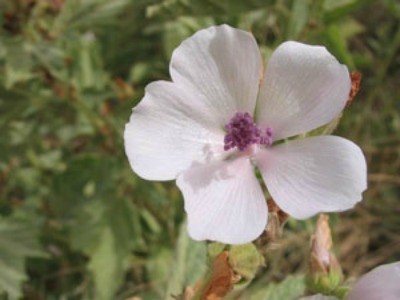
Althaea officinalis
English Mallow, Marsh Mallow
With the right conditions, mallow can grow to 3 or 4 feet high. Native to the marshes and damp meadows of England and Denmark, this lovely perennial herb has been used for its culinary and medicinal properties since ancient times. Pale pink (sometimes white) saucer-shaped flowers sit on top of simple stems with dark-green, velvety oval leaves, giving the plants an appealing informal look, perfect for a country garden.
hardy perennial
sun or partial shade
Like its common name implies, marsh mallow is at home in the marshes. It prefers moist, even soggy soil and will not grow well in warm, dry climates. Sow seeds directly in the ground in the fall or early winter or transplant cuttings taken in spring or from offsets in the fall. Plants will flower in late summer and die back naturally in the winter. Water plants liberally during hot weather unless the site is naturally moist.
division or seed
leaves, roots or stems
Leaves and greens are best when used fresh and should be cut as needed.
Roots: sore throat, bruises, strains, digestive upsets, ulcers; Leaves: poultice for skin conditions; Flowers: mouthwash; English Mallow has been used to treat colds and bronchitis and aids in the recovery of ureters which have been damaged by kidney stones.
use shredded leaves in salads or soups; roots can be partially boiled and fried
hair care, skin care, perennial borders and plantings

About The Author: Ellen Brown is an environmental writer and photographer and the owner of Sustainable Media, an environmental media company that specializes in helping businesses and organizations promote eco-friendly products and services.
Add your voice! Click below to comment. ThriftyFun is powered by your wisdom!